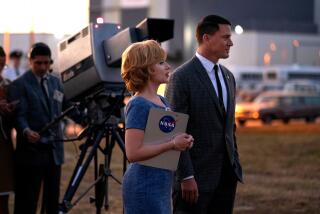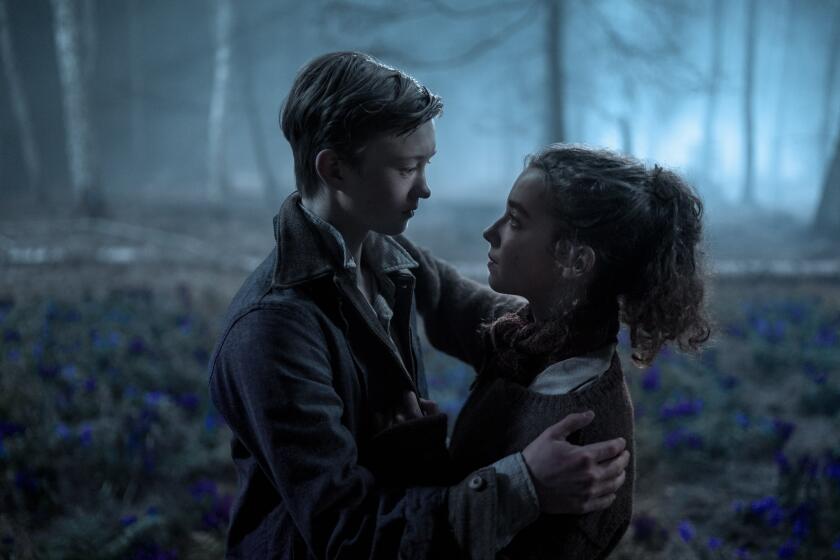MOVIE REVIEWS : Mission Improbable : Ron Howard’s ‘Apollo 13’ Dramatizes Troubled 1970 Space Flight
Apollo 13 (the mission, not the movie) was the space flight no one cared about. Men had been sent to the moon before and presumably would be again. When its trio of astronauts transmitted television pictures back to Earth, the networks couldn’t be bothered to broadcast them live. But, two days-plus into the journey, a handful of words changed everything.
“OK, Houston, we’ve had a problem,” astronaut Jim Lovell radioed to Mission Control, and with that sentence the most attenuated emergency in manned space flight history began: three men in a dying ship 200,000 miles from home needing to survive for 100 hours to preserve any chance of returning. It almost sounds like an entry in the captain’s log of the Starship Enterprise.
The story of that struggle involves as much courage and skill as anything the space program offered. Reading both “Lost Moon,” Lovell and Jeffrey Kluger’s book about that benighted flight, and “A Man on the Moon,” Andrew Chaikin’s excellent examination of the entire Apollo project, underlines why, as Chaikin relates, President Richard M. Nixon resisted pressure to cancel the Apollo series: “The moon program held magic for Nixon for one reason: He liked heroes. . . . It was good for the nation, Nixon believed, to have heroes.”
“Apollo 13,” directed by Ron Howard from a script by William Broyles Jr. and Al Reinert based on Lovell’s book, is certainly a movie of which the late President would have approved. There is no revisionism here, none of the kind of bemused tweaking Tom Wolfe gave the space program in “The Right Stuff.” This film is wall-to-wall with straight-arrow, manly types like Lovell, inevitably played by Tom Hanks, who are such wholesome heroes that it’s something of a shock to remember that all this took place in 1970, not the 1950s of “Father Knows Best.”
Ron Howard, the master of Opie-Vision, is certainly well-suited to the kind of sentimental, middle-of-the-road filmmaking of which “Apollo 13” is the epitome. And because the material to a certain extent cries out for this kind of worshipful treatment, the picture stands as Howard’s most impressive to date. As noted, genuine courage was involved, and Howard is effective at putting the tension and bravery of that mission on screen.
But “Apollo 13” can’t leave well enough alone. Self-conscious about its heroism with portrayals that lean toward the glib and the professionally uplifting, the film milks our sympathies too readily to be emotionally convincing. And its tendency to mimic attitudes of bravery rather than effectively convey them allows a certain hollowness to sink into the inspirational moments.
Before they get lost in space, “Apollo 13” introduces us to the astronauts here on planet Earth. Lovell, with three previous flights, 572 hours and almost 7 million space miles on his resume, is crew commander and pure great guy, devoted in equal parts to wife Marilyn (Kathleen Quinlan), his family and getting to walk on the moon. Although no heavy lifting is involved in the acting department, only someone of Hanks’ presence and charisma could make this character believable and involving.
Lovell’s two partners on Apollo 13 are supposed to be Fred Haise (Bill Paxton) and Ken Mattingly (Gary Sinise), but at the last moment Mattingly gets exposed to German measles and much against his will is replaced by Jack Swigert (Kevin Bacon), a bachelor astronaut who seems to believe that dating different women is within his rights as an American.
The key operative in Mission Control in Houston is flight director Gene Kranz (an excellent performance by Ed Harris). Despite an uncharacteristic belief in the wearing of a lucky vest, Kranz is even more buttoned-down and no-nonsense than the astronauts, qualities that turn out to be much in demand.
For, during the eighth hour of the third day in space, things begin to go seriously wrong. A routine stirring of the liquid oxygen tanks triggers an electrical short and then a major explosion. Not only does the planned landing on the moon have to be scrubbed, but several daunting problems (buildup of carbon dioxide gas in the cabin, a lack of power, question marks about the engines) have to be overcome if the three men have even a hope of making it back to Earth.
Although “Apollo 13” is so jargon heavy it can be unclear exactly what is happening in space, the scramble both in Houston and on board ship to bring everyone back alive is well done and easily the most effective part of the movie. Helped by a completely convincing physical re-creation and Howard’s willingness to be straight ahead with his directing, the film’s derring-do aspects have the advantage of showing the men simply being heroic as opposed to acting like heroes.
But some of the power of this impressive story is undercut by “Apollo 13’s” macho overlay. This is a quintessential guy movie, filled with tough talk, cigarette smoke and no end of significant man-to-man looks. What it resembles most is a war movie without a human enemy, a kind of “combat lite” where heroism and camaraderie can be displayed without the messiness of blowing anybody away.
This kind of subtle hyping of reality is the film’s most persistent problem. “Apollo 13” leads you to believe the men never slept during their ordeal, when in fact they did, albeit badly. It presents a scene of dramatic bickering on board that apparently did not occur. And it shows us corny bad omen scenes like Marilyn Lovell losing her wedding ring in the shower that feel inescapably phony.
Blessed with a great story, which they mostly tell rather well, the filmmakers don’t seem to totally trust it and end up creating, in a phrase used to describe the mission itself, “a successful failure.” They’re so intent on never letting us forget how brave and noble these people were they allow an unnecessary sense of phoniness to intrude on the proceedings. Engrossing though it is, “Apollo 13” feels more like a venerated relic than the realistic tribute it wants badly to be.
* MPAA rating: PG, for language and emotional intensity. Times guidelines: lots of tension.
(BEGIN TEXT OF INFOBOX / INFOGRAPHIC)
‘Apollo 13’ Tom Hanks: Jim Lovell Kevin Bacon: Fred Haise Bill Paxton: Jack Swigert Gary Sinise: Ken Mattingly Ed Harris: Gene Kranz Kathleen Quinlan: Marilyn Lovell An Imagine Entertainment presentation of a Brian Grazer production, released by Universal Pictures. Director Ron Howard. Producer Brian Grazer. Executive producer Todd Hallowell. Screenplay William Broyles Jr. and Al Reinert, based on the book “Lost Moon” by Jim Lovell and Jeffrey Kluger. Cinematographer Dean Cundey. Editors Mike Hill, Dan Hanley. Costumes Rita Ryack. Music James Horner. Production design Michael Corenblith. Art director David J. Bomba, Bruce Alan Miller. Set decorator Merideth Boswell. Running time:2 hours, 15 minutes.
* In general release throughout Southern California.
More to Read
Only good movies
Get the Indie Focus newsletter, Mark Olsen's weekly guide to the world of cinema.
You may occasionally receive promotional content from the Los Angeles Times.











